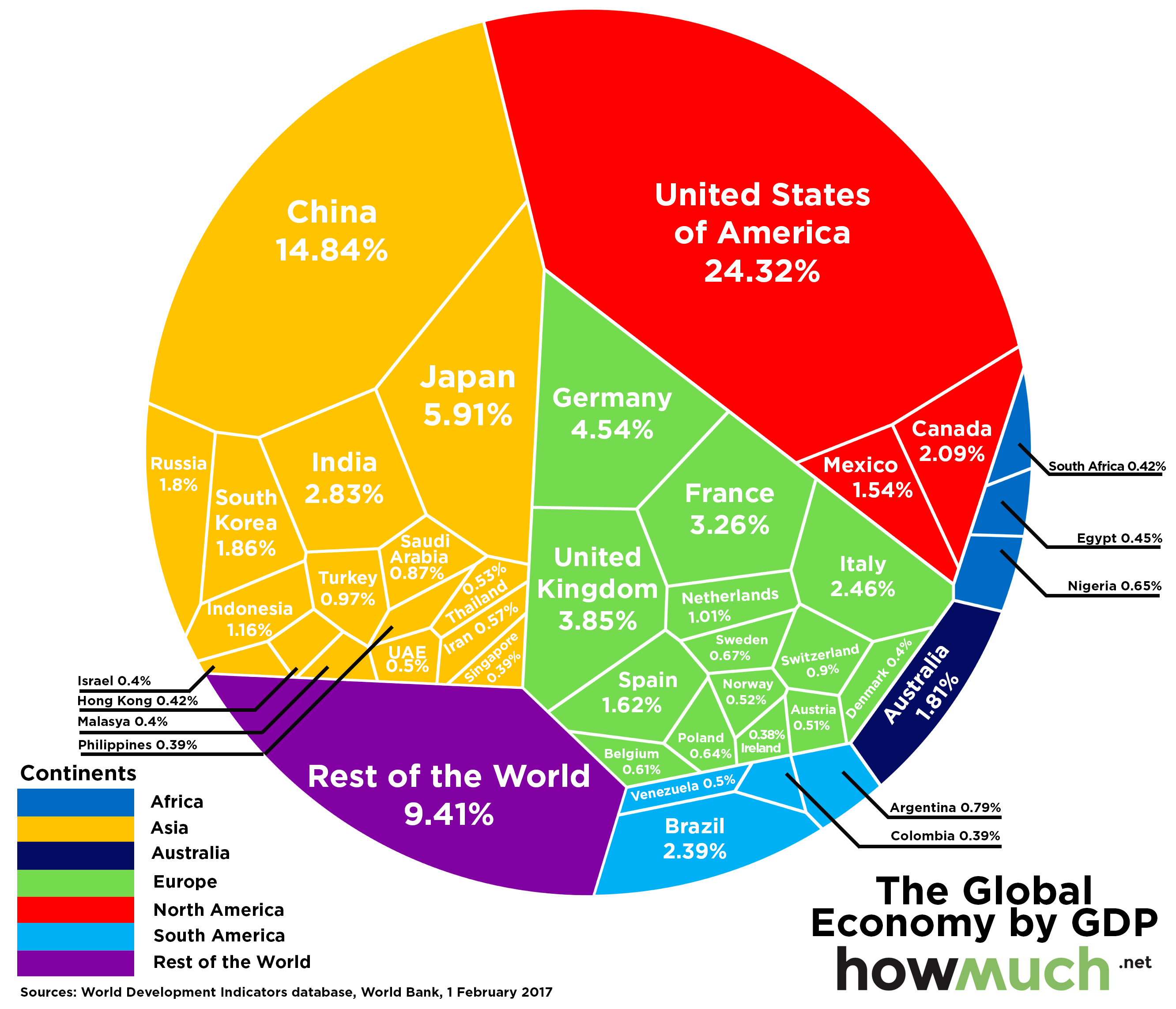This World Economy Chart Contains a Few Hidden Surprises
Feb 24, 2017
According to the latest data on global GDP released by the World Bank this February, the U.S. still is the world's biggest economy – by far. As shown by this Voronoi diagram, the United States (24.3%) generates almost a quarter of global GDP and is almost 10 percentage points ahead of China (14.8%), in second place, and more than 18 percentage points ahead of Japan (4.5%) on three.

Top Ten Ranking (GDP in brackets)
1. United States ($18.03 trillion)
2. China ($11 trillion)
3. Japan ($4.38 trillion)
4. Germany ($3.36 trillion)
5. UK ($2.86 trillion)
6. France ($2.42 trillion)
7. India ($2,09 trillion)
8. Italy ($1.82 trillion)
9. Brazil ($1.77 trillion)
10. Canada ($1.55 trillion)
The U.S. economy is roughly equivalent in size to the total GDPs of #3 through #10 (that’s Japan, Germany, the UK, France, India, Italy, Brazil and Canada - combined). While that puts America comfortably ahead of everyone else (including, for the time being, the Chinese), the story is quite different if we consider continents instead of countries. On this graph, which shows the world’s 40 biggest economies individually, the Asian bloc is clearly dominant. It represents just over a third (33.84%) of global GDP, effortlessly outpacing the North American bloc, which at 27.95% hovers just above the quarter of global GDP that the U.S. hovers under on its own. Europe, meanwhile, has to content itself with third place, and just over one fifth of global GDP (21.37%). Together, these three blocs generate over four-fifths (83.16%) of the world’s total output.
Top Ten Ranking in Asia (with World Bank ranking)
2. China ($11 trillion)
3. Japan ($4.38 trillion)
7. India ($2.09 trillion)
11. South Korea ($1.38 trillion)
13. Russia ($1.33 trillion)
16. Indonesia ($861.9 billion)
18. Turkey ($717.9 billion)
20. Saudi Arabia ($646 billion)
26. Iran ($425.3 billion)
27. Thailand ($395.1 billion)
Asia's economic center of gravity is in the east, with China, Japan and South Korea together generating almost as much GDP as the U.S.
Top Ten Ranking in America (with World Bank ranking)
1. United States ($18.04 trillion)
9. Brazil ($1.77 trillion)
10. Canada ($1.55 trillion)
15. Mexico ($1.14 trillion)
21. Argentina ($583.2 billion)
39. Colombia ($292.1 billion)
42. Chile ($240.8 billion)
48. Peru ($189.1 billion)
58. Puerto Rico ($103.1 billion)
61. Ecuador ($100.2 billion)
Brazil, the economic giant of South America, has less than one-tenth the size of the GDP of the United States.
Top Ten Ranking in Europe (with World Bank ranking)
4. Germany ($3.36 trillion)
5. UK ($2.85 trillion)
6. France ($2.42 trillion)
8. Italy ($1.82 trillion)
14. Spain ($1.2 trillion)
17. Netherlands ($750.3 billion)
19. Switzerland ($670.8 billion)
22. Sweden ($495.6 billion)
24. Poland ($477.1 billion)
25. Belgium ($455.1 billion)
The UK is the second economic power in Europe, which puts into perspective the major economic impact Brexit will have on the European Union.
And that about sums up the world economy. Despite all the talk about emerging economies, the four biggest economies in South America (Brazil, Argentina, Venezuela and Colombia) produce only about 4% of global GDP, while Africa’s three biggest economies (South Africa, Egypt and Nigeria) produce no more than 1.5%.
Besides the 40 largest economies shown individually, the world’s more than 100 other countries lumped together here as ‘rest of the world’ generate just 9.4% of global GDP. These include big countries with low per-capita GDP like Pakistan or Bangladesh, and countries that are relatively rich but too small to make the Top 40, such as Chile or Luxembourg. And, of course, countries that are both poor and small, like Cuba or Yemen. By a curious accident, the ‘Rest of the World’ produces just as much GDP as constitutes the gap between the U.S. and China. That is an awesome indication of the size of America’s advantage over China.
Source: Howmuch.net